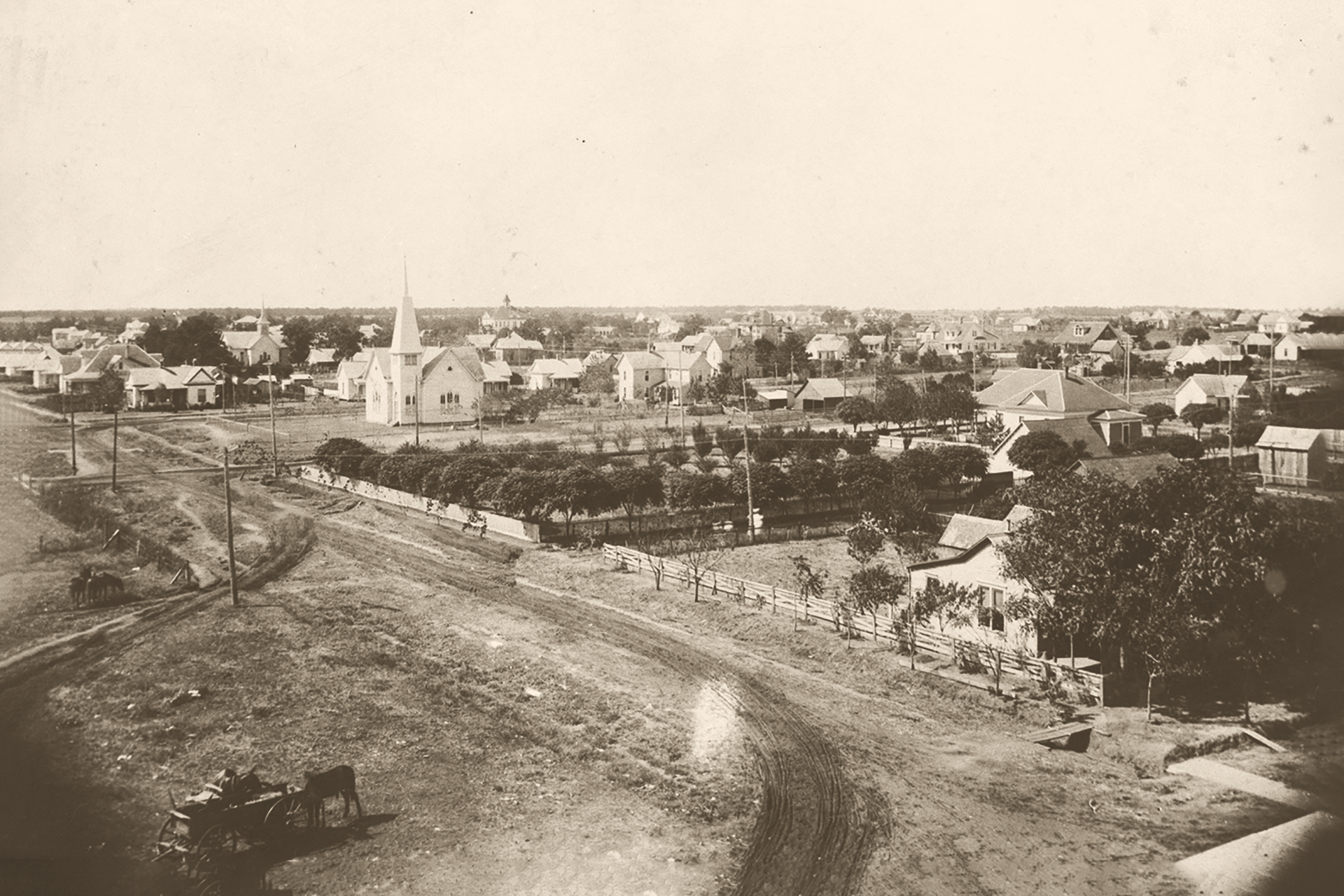
A History of Arlington Street Names (Part 1 of 2)
(This article includes popup citations—to read a citation, simply click on a citation number.)
The presence of Arlington’s pioneers is lost to history — with several notable exceptions. If you’ve lived in The American Dream City awhile, you know names like Abram and Bowen, Cooper and Collins, Davis and Fielder. Indeed, without these pioneering people and many more, we would be lost. The presence of their names connects us to Arlington’s past and gets us where we’re going today. But let’s not put the cart before the horse or the car before the train. Without the arrival of the railroad on July 19, 1876, this story about street names would have taken an entirely different turn.
Beginning in 1862, Congress authorized the construction of not one, but four transcontinental railroads. “Many factors contributed to this legislative initiative, among them the discovery of gold in California, the American civil war, the absence after secession of opposing votes by southern states, and a desire to encourage the settlement and development of the vast new western territories, thereby increasing tax revenues, opening markets, and providing more adequately for the defense of the West.” 1
Arlington’s city-maker, the Texas Pacific Railway (later Texas and Pacific, or T&P), in 1871 was the last of the four to receive federal authorization. That same year, the T&P received approval to build from Marshall, Texas, in the east, to San Diego, California in the west.2 Two years later, the financial Panic of 1873 delayed contract signings for the railroad’s right-of-way through a new community called “Johnson,” and later “Hayterville,” which had developed north of Johnson Station between Dallas and Fort Worth.
“Rev. Andrew Hoyter [sic] … seeing the need of a Post Office for the settlers in this community and Watson, [near today’s State Highway 360] sent a petition to the Postmaster General asking that a Post Office be established in the store of James Ditto, Sr. The community… decided that the mail would be mixed with that of [nearby] Johnston Station, so they decided to change it to Hoyterville [sic]. This name remained until the Texas & Pacific Railroad came through in 1876. Reverend Hoyter [sic] was also a surveyor and was of much assistance to the T. & P. engineers. In appreciation of his services they wanted the new station to retain his name but he objected to the use of his name because it was not generally pronounced like it was spelled. They then gave Hoyter [sic] the priviledge [sic] of naming the new station and he very proudly named the new station Arlington in honor of Gen. Robert E. Lee‘s home near Washington, D. C.” 3
Note: Unlike this article from 1925 in which Rev. Hayter’s name is spelled with an “o,” most historical accounts spell his name with an “a.” The “a” spelling aligns with his reasoning to rename the up-and-coming town: Hayter likely wanted to avoid frequent mispronunciation by those unaware it was pronounced “High-ter.”
When the economic effects of the panic subsided around 1874, the state found they had another problem: Thorny underbrush blanketed the prairie from east of Dallas toward the future Arlington. Their solution? They hired convicts to clear the land and make way for the soon-to-be train tracks. 4
Rev. Hayter surveyed the area and helped the railroad select 160 acres for the new town that crossed two properties, also known as “patents,” in Tarrant County. Where they met, a bumpy, rutted wagon road had naturally developed at the southern boundary of Solomon Davis’ property and the northern line of John Huitt’s land. This would eventually be known as Abram Street. 5
“In those days, a man walking or on horseback could travel freely over the unfenced prairie, but wagons found it better to travel a road, especially through forested areas such as the Cross Timbers at this location. A road along a section line avoids trespassing on the scattered homesteads ….” 6
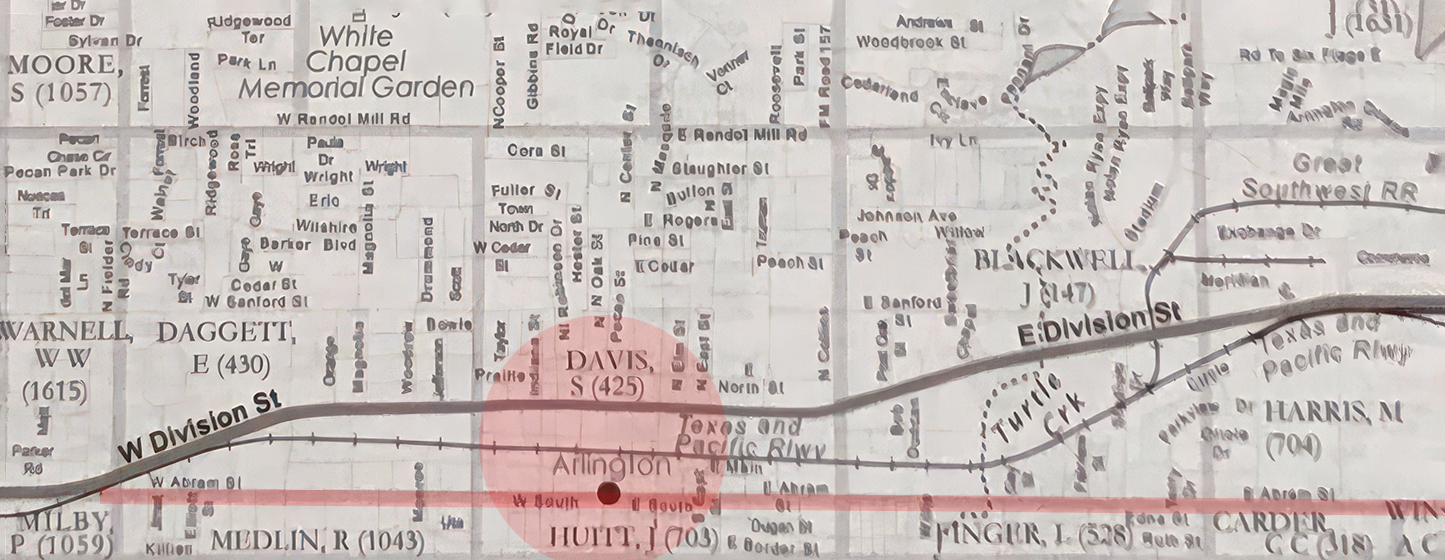
From these organic beginnings, more formalized road development emerged, not only in tiny Hayterville / Arlington, but across the state:
“In 1875, the state legislature divided road construction into classes of roads: first, second, and third. A first class road was to be 60 feet wide, a second class road 40 feet wide, and a third class road 20 feet wide. However, the focus was still on removing stumps “to within six inches of the ground” for dirt roads to ensure efficient horseback travel rather than the construction of any sort of paved road.” 7
Progress was getting closer, as Huitt and Davis’ agreement with the railroad solidified the town’s future. Rev. Hayter and Ditto, who had become the postmaster, are credited with naming Arlington’s first streets and laying out their grid pattern. And, one John M. Litton is credited with stump removal, writes Tom Cogdell in a fascinating article.
Then, finally, the day arrived, July 19, 1876.
After four-plus years of paperwork, negotiations, contracts, surveys, clearing, and track-laying, the first train chugged into the Arlington station, pulled by T&P Engine No. 20. 8
“The first you noticed was the low, deep-throated whistle that carried for miles on the open prairie. Then you would see a plume of dark-gray coal smoke and soot rushing up and away from the smokestack as the train chugged toward the small Arlington station. Burning lubricant gave off a smell like rotten eggs, and escaping steam hissed and engulfed the engine in billowing white clouds.” 9
Tiny Arlington was on the map, so to speak, where she would remain — unlike Johnson Station. The once-larger community lost settlers as they moved three miles north to the new town with the train. Its east-west tracks cut across the half-mile square that would become downtown Arlington. Then as now, the aptly named Center Street runs north to south through the center of the surveyed square. The perimeter of the original survey by Hayter is bounded by North, South, East, and West Streets. You can still drive these streets today to get a sense of where we started and how far we’ve come.
Abram Street
From a 19th-century property line to 20th-century wagon path-turned-road to 21st-century thoroughfare, the east-west stretch that became Abram Street boasts several possible histories. Perhaps the strongest case comes from writer, artist, and historian Arista Joyner, who wrote the book on Arlington’s early history. She credits Col. Abram Harris (1824-1915)10 as Abram Street’s namesake.
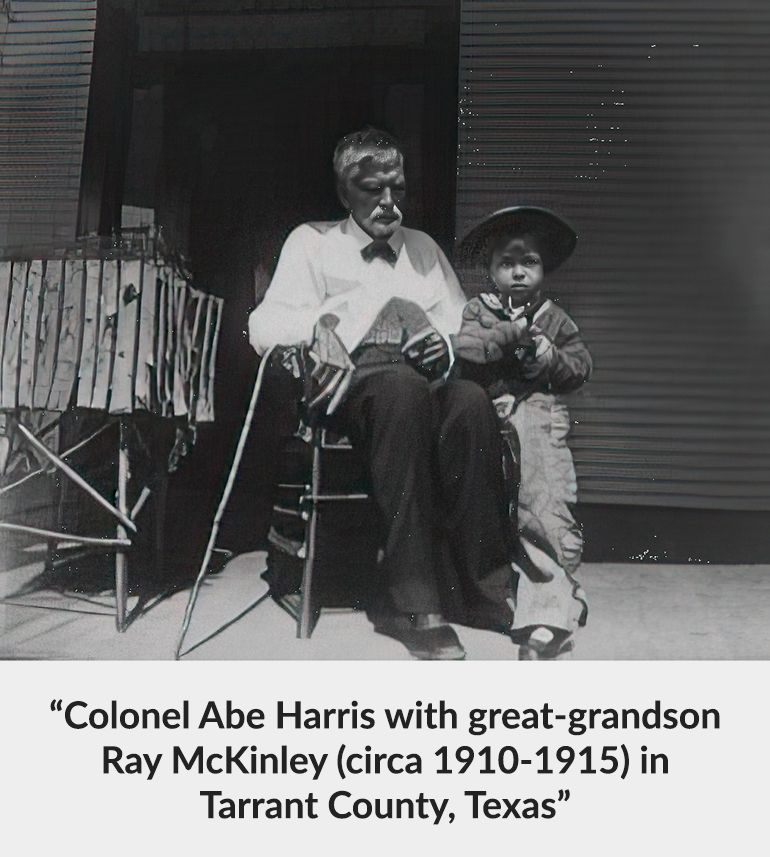
Abram (or Abraham) Harris was born in Leicestershire England, and immigrated to the United States with his family when he was four or five years old. As an adult, Harris served in two wars (Mexican War and U.S. Civil War). “He was a founder of Fort Worth, an accomplished cabinetmaker, and a prominent Baptist,” Joyner writes. He purchased land in Arlington in 1888, though he maintained his home in Fort Worth.. He died March 28, 1915, and is buried in Block 3-Lot 16 of Pioneer’s Rest Cemetery in Fort Worth. 11
In a contending narrative from 1925, the Arlington Journal published a brief story about Arlington’s history on Oct. 16, by an Edna Christman. She cites “a few old citizens and a few Masonic Home papers” as her sources. She writes,
“Abram Street, which is the old Fort Worth and Dallas pike, received its name from an old employee of the T. & P. railroad company, who did much to help their progress.” 12
Note: A “pike” was a long pole that was used to stop wagons, and later cars, so their drivers could pay a toll. Once paid, the pike was turned out or moved up to allow passage. This is where we get the word, “turnpike.”
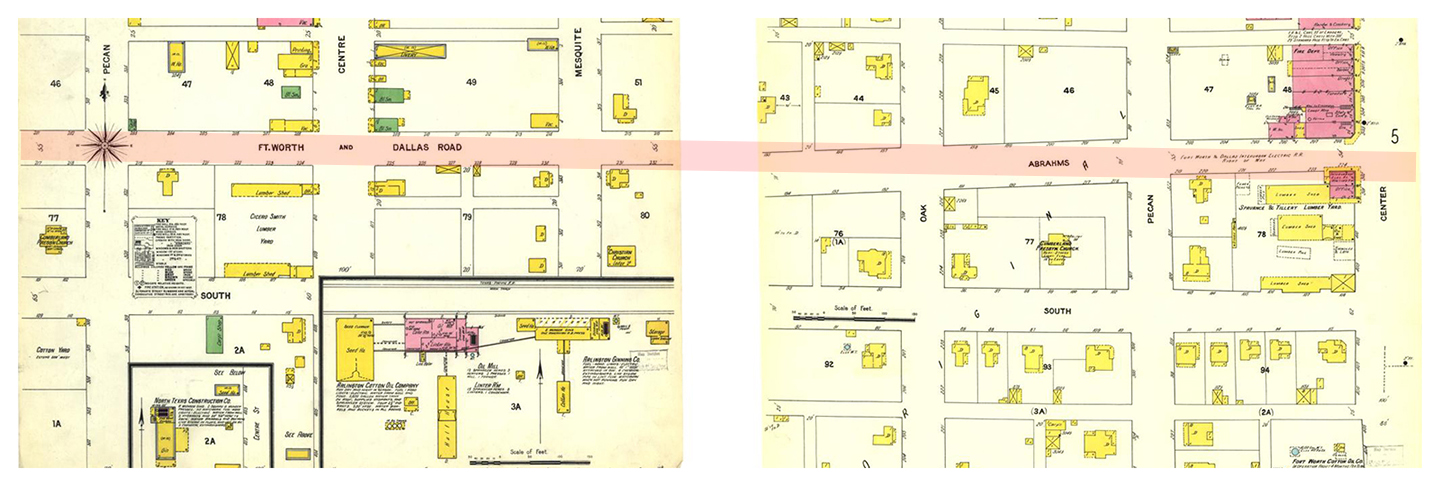
And then, there is a derivative of “Abram,” noted by author Steve Barnes in a November 2010 article for the Arlington Historical Society:
“The earliest known name given the road was Abraham, who, according to a 1925 N.T.A.C Shorthorn article was a long-time employee of the T&P Railroad who did much to help the new town’s progress. This name would change over time from Abrahms, and Abrams, prior to reaching its present name of Abram.” 13
Given the similarity in word choice and the year of publication (1925), it is possible that Edna Christman’s story in the Arlington Journal is the same story mentioned in the N.T.A.C. article.
But the plot thickens. The namesake of Abram Street could be W.W. Abrams, “a land commissioner who dispensed titles along the wagon road that would become Abram . . .,” writes O.K. Carter in Caddos, Cotton and Cowboys: Essays on Arlington. 14
Maybe this is the T&P employee referenced in news accounts? The question remains: Whose account is correct? Will the real namesake of Abram Street ever be decisively identified? Let’s hope so, as more clues come to light. Until then, we will continue our journey by heading west on Abram and making a hypothetical left turn on to Bowen Road.
Writer’s quip: Astute Arlington residents know that a right turn from Abram to Bowen — picture Kroger on your right — puts you smack-dab in front of the train tracks and the inevitable train, precisely when you’re in a hurry … and we’ve got to keep this story moving!
Bowen Road
William A. Bowen was born April 14, 1856, in Bagdad, Florida. His father, a Confederate soldier, moved the family to Montgomery County in East Texas at some point before or during the Civil War. After it was over, the Bowen family moved to Galveston, where, as a teenager, William began working as a printer’s apprentice for the Galveston News. Through his career, William Bowen worked for a variety of papers including smaller publications in Decatur and Montague, Texas; The Dallas Herald, The Houston Post, The San Antonio Express, as well as papers in Chicago and St. Louis. When Bowen was 21 years old, he married Ada De Bardeleben, the daughter of a Louisiana physician. They had four children, a daughter, Merle, by birth, and three adopted children, Lily, Chester, and Mary Catherine. 15
In addition to newsgathering and reporting, Bowen believed in education and spent several years early in his career as a teacher, and later, a high school principal, writes Phyllis Forehand in her 1977 Master’s dissertation at North Texas State University, today’s University of North Texas.
In 1908, Bowen moved to Arlington to become editor of the Arlington Journal and president of the Arlington Printing Company, which published the paper. Bowen loved this town and coined the phrase, “The Great Arlington Country,” in his zeal to promote Arlington’s merits. In addition to his news-related pursuits, Bowen was also a writer for other publications, author of two books, and “a backer of the Chautauqua movement, traveling groups that moved from town to town during the summer giving programs of lectures, recitals, and concerts.” 16
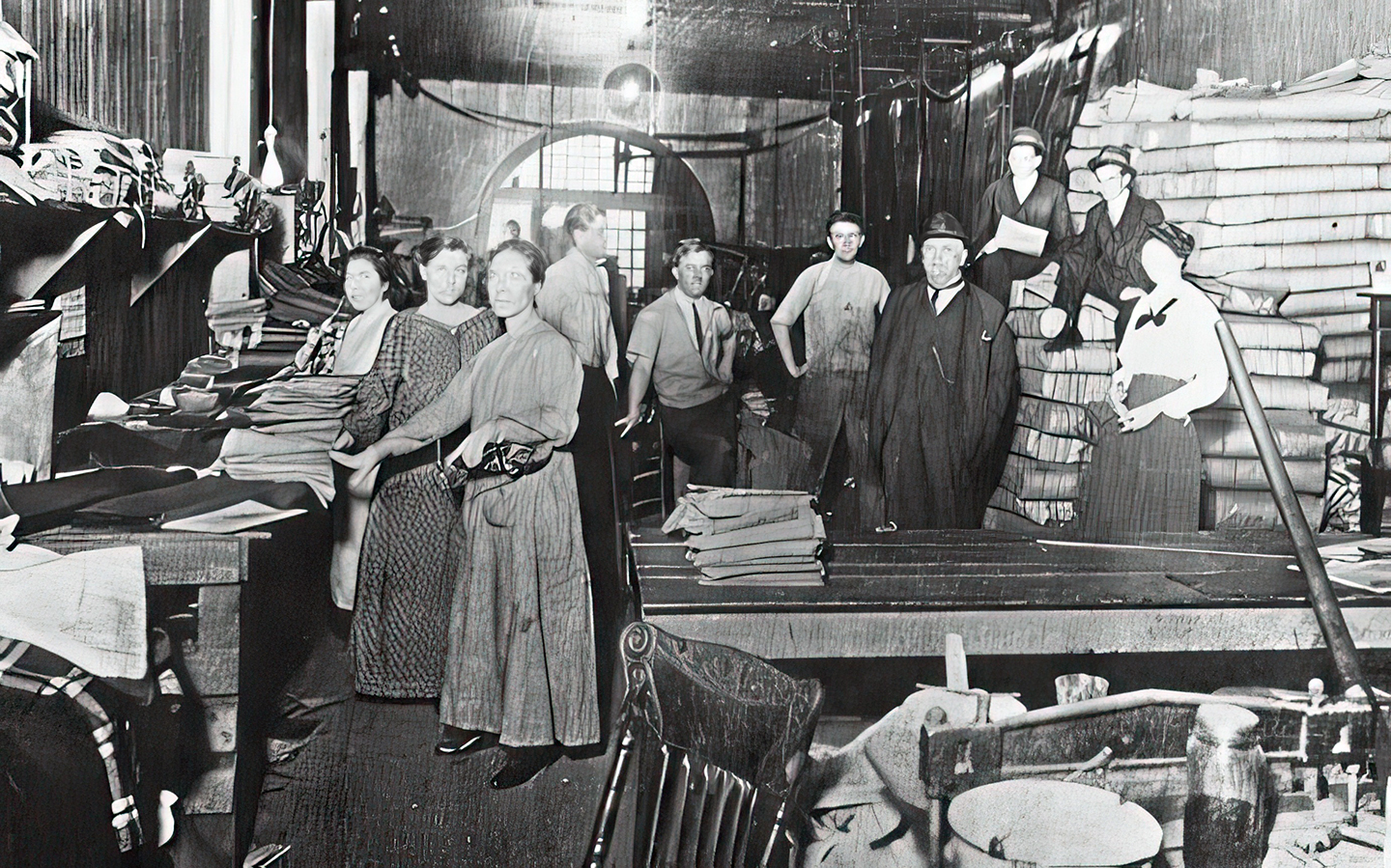
Of the “Colonel,” O.K. Carter, a subsequent editor and publisher of the Arlington Citizen-Journal wrote:
“[H]e influenced the transition of Grubb's Vocational School to become part of Texas A&M (UT System today), persuaded voters to ditch, so to speak, their septic tanks in favor of the city's first sewage treatment system, and — ever the community booster — he ramrodded creation of a chamber of commerce. The road was named for him after his death. The colonel would have liked that.” 17
Bowen edited the Journal for a decade before a cancer diagnosis in 1918. For the next three years, he worked as he was able, but a hospitalization in Sherman in 1920, effectively marked the end of his career.
“He sent a message from Sherman, assuring the citizens he had left good people in charge and urged that the organization of a Chamber of Commerce be continued. In mid-June, Bowen returned to Arlington, but reported that he was a permanent shut-in and an incurable. A constant stream of prominent people began to visit the ailing editor at his home on North Center Street. Citizens who can remember Bowen, related that the formerly tall, robust editor had wasted away to a shadow of his former self.” 18
William A. Bowen passed away April 15, 1921, just one day after his sixty-sixth birthday. He rests eternally within Arlington Cemetery at 801 S. Mary St. The street that bears his name stretches seven miles from Westwood Drive in the north to Sublett Road in the south.
Rest Stop
In part two of A History of Arlington Street Names, we will get to know James and Mattie Fielder, the Collins brothers, J.D. Cooper, and the origins of Davis Drive.
